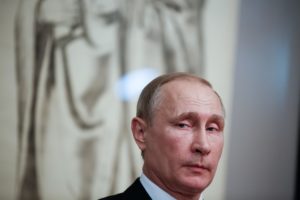March 2, 2018
Jeffrey Lewis
The following is an excerpt of an op/ed published in the Chicago Tribune.
President Donald Trump’s Nuclear Posture Review proposed that the United States create two new nuclear weapons — a low-yield warhead for U.S. submarine-launched ballistic missiles and a new sea-launched cruise missile.

Vladimir Putin (src: shutterstock.com)
So, naturally, Russian President Vladimir Putin just asked the Federal Assembly to hold his beer.
Speaking before the Assembly in what is, more or less, Russia’s equivalent to the State of the Union address, Putin announced a series of new weapons systems, including four new or recent systems designed to defeat U.S. missile defenses. Each was accompanied with a short film that mixed real footage with animation. The fun bits are:
- A giant liquid-fueled intercontinental ballistic missile called the Sarmat. Putin showed an animation of the Sarmat that made the point that it was powerful enough to travel over the South Pole and strike the United States, a route that would conveniently evade any missile defenses.
- A maneuvering re-entry vehicle that will arm Russia’s other ICBMs, allowing them to penetrate U.S. missile defense systems.
- A nuclear-powered underwater drone capable of traveling thousands of miles before detonating in a U.S. port, all the while staying submerged where there are no missile defenses.
- Last, but certainly not least, a global-range, nuclear-powered — that’s right, nuclear-powered — cruise missile that is externally identical to Russia’s X-101 cruise missile.
In a charming twist, Putin explained that the Russians have yet to choose names for the nuclear-powered cruise missile and unmanned underwater vehicle, asking the public to offer suggestions.
Ph.D. student Marty Pfeiffer is already suggesting the name Missile McMissile-Face. You can submit your suggestions for a name at the Russian Ministry of Defense website: http://vote.mil.ru.
We already knew about some of these systems, including the Sarmat and the nuclear-powered doomsday torpedo. And we knew, generally, that Russia was developing a maneuvering re-entry vehicle to penetrate missile defenses. Still, Putin offered a lot more detail than was previously available.
Continue reading at the Chicago Tribune.
